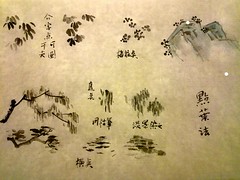Dots are very useful in landscape painting. To depict tree leaves, often we have to do a lot of them, and to do them willy-nilly can lead to chaos. Thus, it is helpful to do them in clusters. Examples of such are shown in the above figure. A cluster of 4 is shown in the upper left, and comes in pointy or blunt variety. A blunt type was used in the the Daijin picture. The clusters are best done with some overlap, and distributed irregularly. For a lively effect, the distribution should be irregular -- some overlap, some spaced apart, some concentrated, some dispersed, etc.
Clusters of 5 arranged like the petals of a flower are in the upper right. Note the 5-configuration can have variations in itself, some arranged in a round pattern, some in a flat pattern. I also show this pattern crowning the rocks.
Vertical dots dots are shown next. These are best done using a very dry brush with bristles somewhat splayed. The stroke starts off heavy (top) and ends light (bottom). Then one can go over them with lighter ink strokes to give depth (after the strokes have dried). This is the common practice to give depth. The horizontal dots can be done as a dragging motion of the brush at a shallow angle, again with a dry brush. Going over with light ink again adds depth.
A few final words. Vary the pattern. For the 4-cluster, vary the orientation, length, width of the 4 strokes For flower pattern, vary the arrangement as discussed above. Vary the ink tones. Vary the size and width; (vary the pressure of the strokes and wetness and ink content in the brush). In dotting a tree, the dots at the periphery of the tree are most important. They show the most clearly, and should be done with more care.
Subscribe to:
Post Comments (Atom)



No comments:
Post a Comment